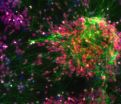(Press-News.org) Rett syndrome, a neurodevelopmental disorder on the autism spectrum, is marked by relatively normal development in infancy followed by a loss of loss of cognitive, social and language skills starting at 12 to 18 months of age. It is increasingly seen as a disorder of synapses, the connections between neurons that together form brain circuits. What hasn't been clear is why children start out developing normally, only to become progressively abnormal. New research from Children's Hospital Boston, published in the April 14 issue of Neuron, helps unravel what's going on.
The researchers, led by Chinfei Chen, MD, PhD, of Children's F.M. Kirby Neurobiology Center, studied synapse development in mice with a mutation in the Mecp2 gene, the same gene linked to human Rett syndrome. They found strong evidence that the loss of functioning Mecp2 prevents synapses and circuits from maturing and refining in response to cues from the environment – just at the time when babies' brains should be maximally receptive to these cues.
Chen believes her findings may have implications not just for Rett syndrome, but for other autism spectrum disorders. "Many ASDs manifest between 1 and 2 years of age, a period when kids are interacting more with the outside world," says Chen. "The brain of an autistic child looks normal, but there's a subtle difference in connections that has to do with how they process experiences. If you could diagnose early enough, there might be a way to alter the course of the disease by modifying experience, such as through intense one-to-one therapy."
Chen and colleagues focused on a synaptic circuit in the brain's visual system that is relatively easy to study, known as the retinogeniculate synapse. It connects the cells receiving input from the eye to the lateral geniculate nucleus, an important relay station in the brain's thalamus. Visual input from the outside world, during a specific "critical period," is crucial for its normal development.
The team tested the functioning of the circuit by stimulating the optic tract and measuring electrical responses in the thalamus to see how the neurons were connected, and how strong the connections were. In Mecp2-mutant mice, these recordings indicated that the visual circuit formed normally at first, and that during the second week of life, weaker connections were pruned away and others strengthened, just as they should be.
But after day 21 of life – after mice open their eyes and when the visual circuitry should be further pruned and strengthened based on visual experience – it became abnormal. The number of inputs and connections actually increased, while the strength of the synapses decreased.
This pattern was similar to that seen when normal mice were kept in the dark after day 21, depriving them of visual stimulation. Together, the findings suggest that Mecp2 is critically important to our ability to refine synaptic circuits based on sensory experience, says Chen. Without Mecp2, the circuit fails to incorporate this experience.
"During this last phase of development, you need sensory input to lock down and stabilize the connections," Chen explains. "But the circuit is not getting the right signal to stabilize, and continues to look around for the right connections."
In patients with Rett syndrome, the reduction in Mecp2 levels is especially striking in the thalamus, which processes and relays sensory information to the cortex, where thought, memory and language reside. "It's very telling that we see these synaptic abnormalities in the thalamus, which is like a switchboard operator for the brain," says Chen. "A small disruption in the thalamus can radiate to large areas of the cortex."
This model of Rett syndrome is consistent with mouse models of other autism-related disorders like Fragile X and Angelman syndrome, which also show abnormalities during experience-dependent maturation of circuits, the researchers say.
"There could be a problem with how information is taken in," Chen says. "What's being perceived is different, so the response is different."
Chen and colleagues are now investigating whether reactivating Mecp2 at different times could improve organization of the visual circuitry.
###
Joao Noutel was the study's first author. The study was supported by the National Institutes of Health and the Fundacao para a Ciencia e Tecnologia, Portugal.
Children's Hospital Boston is home to the world's largest research enterprise based at a pediatric medical center, where its discoveries have benefited both children and adults since 1869. More than 1,100 scientists, including nine members of the National Academy of Sciences, 12 members of the Institute of Medicine and 13 members of the Howard Hughes Medical Institute comprise Children's research community. Founded as a 20-bed hospital for children, Children's Hospital Boston today is a 392-bed comprehensive center for pediatric and adolescent health care. Children's also is the primary pediatric teaching affiliate of Harvard Medical School. For more information about research and clinical innovation at Children's visit: Vector Blog.
END
WASHINGTON – Approximately one million Americans suffer a heart attack each year of which some 400,000 attacks are fatal. A key cause of heart attacks is atherosclerosis, a process in which cholesterol builds up in the arteries and impedes the ability of the blood to flow to our most vital organ. Atherosclerosis is often associated with a high-fat diet in humans, but in a new study using an animal model researchers have found that a high-fat diet for a very short period can protect the heart from heart attacks and result in less tissue damage when heart attacks occur. ...
WASHINGTON – Walking on a treadmill for one hour a day may slow the progression of nonalcoholic fatty liver disease in obese people with prediabetes by jump-starting their metabolism and slowing the oxidative damage wrought by the condition, say researchers at the Cleveland Clinic. A study of 15 obese people with nonalcoholic fatty liver disease revealed that the daily walks not only increase insulin sensitivity, but improve the liver's polyunsaturated lipid index (PUI), which is thought to be a marker of liver health.
The improvements are linked to an increase in the ...
CINCINNATI—A new study from researchers at the University of Cincinnati (UC) shows that short-term, high-fat "splurges" within one's diet could elicit cardioprotective properties during a heart attack.
These findings are being presented for the first time at the 2011 Experimental Biology Meeting sponsored by the American Society for Pharmacology and Experimental Therapeutics on April 13 in Washington, D.C.
Lauren Haar, a doctoral student in the Systems Biology and Physiology Graduate Program, found that short-term, high-fat feeding in animal models led to cardioprotection ...
GRAND RAPIDS, MICH., April 13, 2011 – Although only one in 10 American adults eats enough fruits and vegetables (1), new research being presented at the Experimental Biology meeting this week in Washington, D.C., finds older adults are consuming higher levels of carotenoids, flavonoids and other phytonutrients found in fruits and vegetables that are thought to support healthy aging. Specifically, the new findings suggest that, calorie for calorie, intakes of carotenoids are 20 percent higher, flavonoids 40 percent higher, and ellagic acid is 80 percent higher among older ...
ROCHESTER, Minn. -- A new research study of the effect of a commonly used strategy to reduce the spread of antibiotic-resistant bacteria in hospital intensive care units (ICU) shows that the strategy had no significant effect. That's the surprising finding of a multisite study led by Mayo Clinic investigators. The bacteria -- methicillin-resistant Staphylococcus aureus (MRSA) and vancomycin-resistant enterococcus (VRE) -- are resistant to common antibiotics and harder to treat if patients become infected. The findings appear in today's New England Journal of Medicine (http://www.nejm.org/).
The ...
A team of scientists at Penn State University, the Salk Institute for Biological Studies, and other institutions have developed a method for recreating a schizophrenic patient's own brain cells, which then can be studied safely and effectively in a Petri dish. The method brings researchers a step closer to understanding the biological underpinnings of schizophrenia. The method also is expected to be used to study other mysterious diseases such as autism and bipolar disorder, and the researchers hope that it will open the door to personalized medicine -- customized treatments ...
LA JOLLA, CA- After a century of studying the causes of schizophrenia-the most persistent disabling condition among adults-the cause of the disorder remains unknown. Now induced pluripotent stem cells (iPSCs) generated from schizophrenic patients have brought researchers from the Salk Institute for Biological Studies a step closer to a fundamental understanding of the biological underpinnings of the disease.
In their study, published in the April 13, 2011 advance online issue of the journal Nature, the Salk team reports both that neurons generated from these patient-derived ...
A new MRI device that guides surgeons as they implant electrodes into the brains of people with Parkinson's disease and other neurological disorders could change the way this surgery, called deep brain stimulation, is performed at medical centers across the country, according to a group of doctors at University of California, San Francisco.
Deep brain stimulation can help to alleviate patients' symptoms, and the new device will make the procedure faster and more comfortable for the patient. It grew out of a home-grown technique developed by a team of UCSF neurosurgeons ...
NGC 3582 is part of a large star-forming region in the Milky Way, called RCW 57. It lies close to the central plane of the Milky Way in the southern constellation of Carina (The Keel of Jason's ship, the Argo). John Herschel first saw this complex region of glowing gas and dark dust clouds in 1834, during his stay in South Africa.
Some of the stars forming in regions like NGC 3582 are much heavier than the Sun. These monster stars emit energy at prodigious rates and have very short lives that end in explosions as supernovae. The material ejected from these dramatic events ...
Paleontologists from the American Museum of Natural History and the Chinese Academy of Sciences announce the discovery of Liaoconodon hui, a complete fossil mammal from the Mesozoic found in China that includes the long-sought transitional middle ear. The specimen shows the bones associated with hearing in mammals— the malleus, incus, and ectotympanic— decoupled from the lower jaw, as had been predicted, but were held in place by an ossified cartilage that rested in a groove on the lower jaw. The new research, published in Nature this week, also suggests that the middle ...



